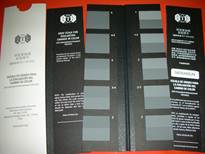Purpose of Test
The accelerated laundering test evaluates how a textile loses its coloring under expected washing conditions. The textile’s colors are expected to resist frequent washing and you want to be sure it can before it is sent to market.
This test uses a washing machine set at 49°C. The test lasts for about 45 minutes.
The loss of fabric color and surface changes result from the use of detergent solutions and abrasive activity of 5 typical hand or machine washings, with or without chlorine.
The acceleration used in the test is defined by:
- Higher temperature
- Low liquor ratio
Terminology Defined
Colorfastness – Colorfastness is a fabric’s ability to retain color in various conditions.
Laundering – Removal of stains or dirt from fabric by washing with a detergent solution.
Gray Scale for Staining – The Gray Scale for Staining is used in colorfastness tests for evaluating staining on undyed textiles. The scale has shades of gray correlated with numbers that allow a tester to match shades with a numerical score.

Test Method
Materials Used for Test
- Automatic washing machine
- Automatic tumbler dryer
- Drip dry and line dry facilities
- AATCC Standard Reference Detergent
- Test specimen
- Gray Scale for Staining
- Gray Scale for Color Change

Testing Procedure
The test specimens are tested under the condition of a temperature of 49°, detergent solution bleach, and abrasiveness of laundering. The test is evaluated by the color change relatively similar to that occurring in about 5 hand and at-home machine washings.
Test Procedure (Summary)
Part 1: Preparation of test specimen: The fabrics are cut for preparation for laundering. One unwashed piece will be kept for comparison after the test. The laundry method will also be identified.
Part 2: Laundering: The AATCC Standard Reference Detergent is added in the washing machine. The test fabric will be put in the wash. The washer is set at 49°. After the last spin cycle, the test specimens are removed from the washer.
Part 3: Drying with a dryer: The test specimens are put in a tumble dryer at the recommended setting from the care instructions. Over drying is avoided.
Part 4: Drying by line or drip: If drying by drip or line, the fabrics must be hung in a vertical direction to promote drying at air and room temperature.
Part 5: Drying with a screen: To dry with a screen, the test specimen is laid on a horizontal screen. The wrinkles are removed without stretching the fabric. The test specimen is left to dry at air and room temperature.
Part 6: Completion of wash and dry cycles: The test specimens must complete the five wash and dry cycles by repeating the previous steps. Condition the textiles in a standard atmosphere for a minimum of 4 hours before evaluation.
Part 7: Evaluation: Color loss is evaluated by comparing the washed and unwashed textiles side by side. The Gray Scale for Color Change is used as a guide.